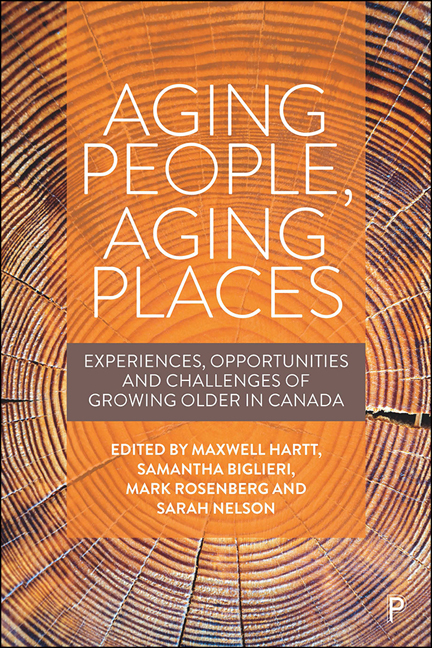1 - Aging in urban Canada
Published online by Cambridge University Press: 18 December 2021
Summary
In this overview chapter, we call upon data from Statistics Canada and the academic literature to present some stylized facts and figures regarding urban older adults and a synthesis of the challenges and opportunities of aging in urban environments. This chapter serves to provide (1) a snapshot of Canadian urban demographic trends, (2) an overview of the state-of-the-art thinking on urban aging, and (3) contextual framing for the in-depth research chapters and vignettes that make up the urban part of this book.
Canada is predominantly a nation of rural spaces. By land area, urban locations occupy only 0.25% of Canada's 9.9 million square kilometres. However, urbanization is quickly changing the national landscape. While Canada's urban areas are growing steadily, they are simultaneously driving considerable suburban growth in their periphery. As we note in Chapter 6, Canada is a suburban nation. And those huge suburbs are growing around Canada's urban centres. The three largest metropolitan areas (which include both urban and suburban areas), Toronto, Montréal, and Vancouver, are home to more than a third of all Canadians, with a combined population of 12.5 million (Statistics Canada, 2019).
For many, urban Canada evokes images of these three iconic cities. Big, bustling conurbations with dense downtowns, skyscrapers, and expensive housing. But like suburban and rural areas, urban regions can take a variety of shapes and forms. Although there is no one perfect definition of ‘urban’, we adopt the following operational definition in order to provide a generalized overview of urban demographic trends in Canada: urban areas are dissemination areas (as defined by Statistics Canada) with a population density of 5,000 or more people per square kilometre, or areas with a population density of 1,000 to 5,000 people per square kilometre where fewer than 60% of population commutes by car (Channer et al, 2020).
Using data from the Statistics Canada (2019) population estimates, we found that 5.3 million of Canada's roughly 35 million people live in urban areas. Of those 5.3 million, approximately 800,000 are aged 65 and over. Across Canada, the number of residents aged 65 and over is growing, and urban settings are no exception. Proportionally, 15% of Canada's urban population are aged 65 and over, lower than suburban (17%) and rural (18%) locations.
- Type
- Chapter
- Information
- Aging People, Aging PlacesExperiences, Opportunities and Challenges of Growing Older in Canada, pp. 15 - 26Publisher: Bristol University PressPrint publication year: 2021



